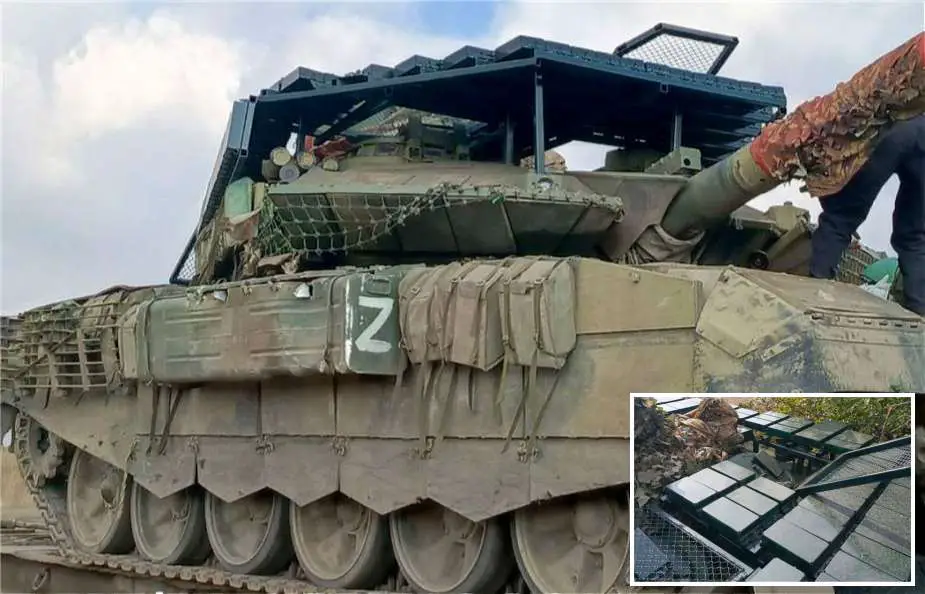- Army
- Conflicts in the world
- Israel - Iran conflict 2025
- Pakistan - India Conflict 2025
- Russia Ukraine War 2022
- Libya conflict day by day
- HAMAS - Israel War 2023
- Operation Serval in Mali French Army
- Sangaris operation Central African Republic
- Sangaris opération militaire République Centreafrique
- Ukraine - Russia conflict
- Syria conflict news
- Defence & Security Industry Technology
- Armies in the world
- Analysis Defense and Security Industry
- Conflicts in the world
- Navy
- Air
Russian T-90M Tanks in Ukraine Receive ERA Advanced Armor to Counter Drone Threats
Several Russian T-90M Main Battle Tanks (MBTs) deployed in Ukraine are now equipped with an advanced anti-drone armor package including Block 1 ERA (Explosive Reactive Armor). This upgrade comes in response to the rising threat posed by loitering munitions, commonly known as "suicide drones." These munitions have been a game-changer in modern warfare, particularly due to their capability for top-attack strikes against tanks.
Follow Army Recognition on Google News at this link

Russian T-90M equipped with hybrid anti-drone armor mixing wire cage and ERA Explosive Reactive Armor mounted on the roof and sides of the turret. (Picture source Russian Social Network VK)
The advent of loitering munitions in conflict zones like Ukraine has introduced a novel and potent threat to tanks, particularly through their capability for top-attack strikes. These advanced weapons systems, merging the features of drones and guided missiles, are uniquely suited for this kind of attack. Their ability to loiter quietly above a battlefield makes them less detectable than traditional aerial threats, allowing them to patiently surveil and choose the opportune moment and angle for an attack.
The most significant threat to tanks from these munitions is their precision in executing top-attack strikes. Tanks, despite their heavy armor, have a notable vulnerability: their top cover is typically less armored than the sides and front. Loitering munitions exploit this weakness effectively. Equipped with sophisticated targeting systems, they can execute strikes from above with high accuracy, penetrating the tank's less-protected areas.
This method of attack is a game-changer in armored warfare. Traditional defensive measures and armor configurations of tanks are less effective against threats from above. The top-attack strategy undermines the very foundation of tank defense, which is predicated on frontal and lateral armor protection.

The sides of the turret are fitted with an additional ERA to provide a second layer of protection. (Picture source Russian social network VK)
The new armor package on the T-90M is a hybrid design, combining cage armor with the Contact 1 Bloks Explosive Reactive Armor (ERA). This combination aims to provide enhanced protection against the precision top-attack strikes carried out by loitering munitions. These drones, which blend the features of unmanned aerial vehicles and guided missiles, have become a notable threat to armored vehicles. They exploit the typical vulnerability of tanks — their less armored top cover — by executing strikes from above with high accuracy.
The Russian Contact 1 Explosive Reactive Armor (ERA) Block 1 is a sophisticated armor technology utilized to enhance the defensive capabilities of armored vehicles against anti-tank munitions. This ERA system operates by significantly diminishing the effectiveness of incoming projectiles, particularly those from anti-tank guided missiles (ATGMs) and shaped charges, which are prevalent in modern warfare. Its core mechanism involves tiles or blocks filled with explosives that react upon impact with a projectile. This explosive reaction disrupts the penetrative force of the projectile, especially effective against shaped charges that operate by focusing explosive energy to penetrate armor. The ERA's explosive reaction is designed to disperse the energy of these charges, reducing their ability to penetrate the armored vehicle.
Contact 1 ERA's modular design is a key feature, allowing for easy replacement of damaged or detonated blocks, facilitating field maintenance and ensuring sustained protection. Its adaptability allows it to be fitted to various parts of an armored vehicle, offering a customizable defense solution. This ERA technology has become particularly relevant in the context of modern conflicts, like the ongoing situation in Ukraine, where armored vehicles face a wide range of anti-tank threats. The integration of such advanced protection systems reflects the continuous evolution in military technology and tactics, aiming to counter emerging threats and enhance the survivability of armored vehicles in diverse combat scenarios
This move to upgrade the T-90M's defenses is a clear indication of the evolving nature of armored warfare on the Ukrainian battlefield. Traditional tank defense strategies, focusing primarily on frontal and lateral protection, are increasingly inadequate against these new aerial threats. The introduction of such an anti-drone armor package represents a strategic shift, acknowledging the need to adapt to the changing dynamics of modern combat, where loitering munitions pose a significant challenge.
The effectiveness of this new armor configuration in countering the threats posed by loitering munitions will be closely watched. As the conflict in Ukraine continues to evolve, so too does the technology and tactics employed, reflecting the continuous cycle of adaptation and counter-adaptation in military technology.

The rear part of the turret also has an additional wire cage armor. (Picture source Russian social network VK)
News Russia Ukraine War


























